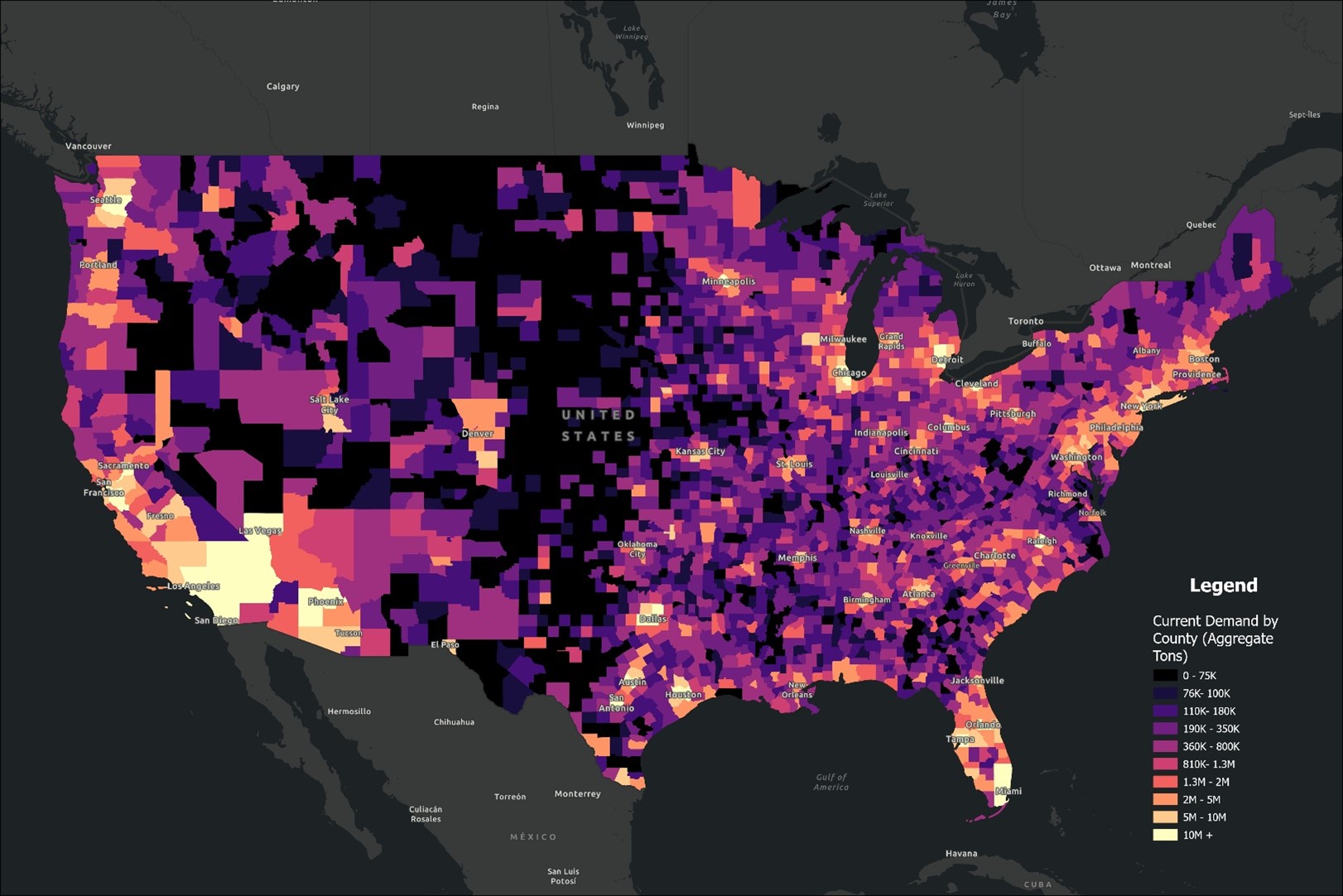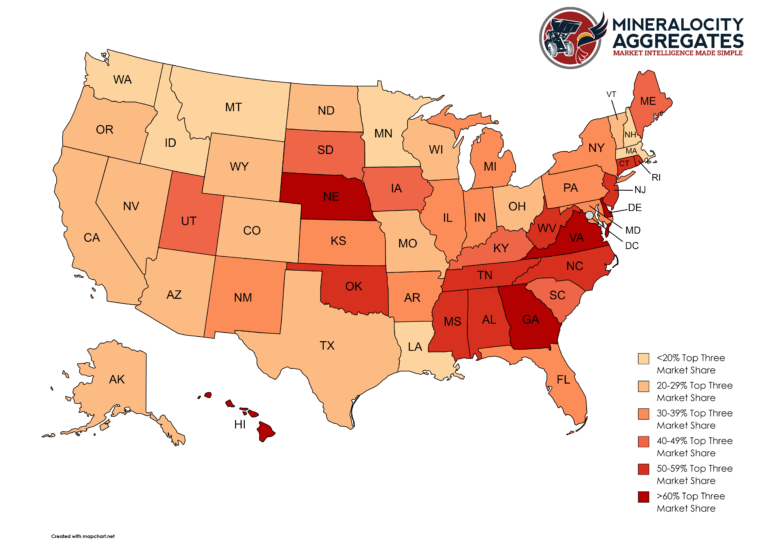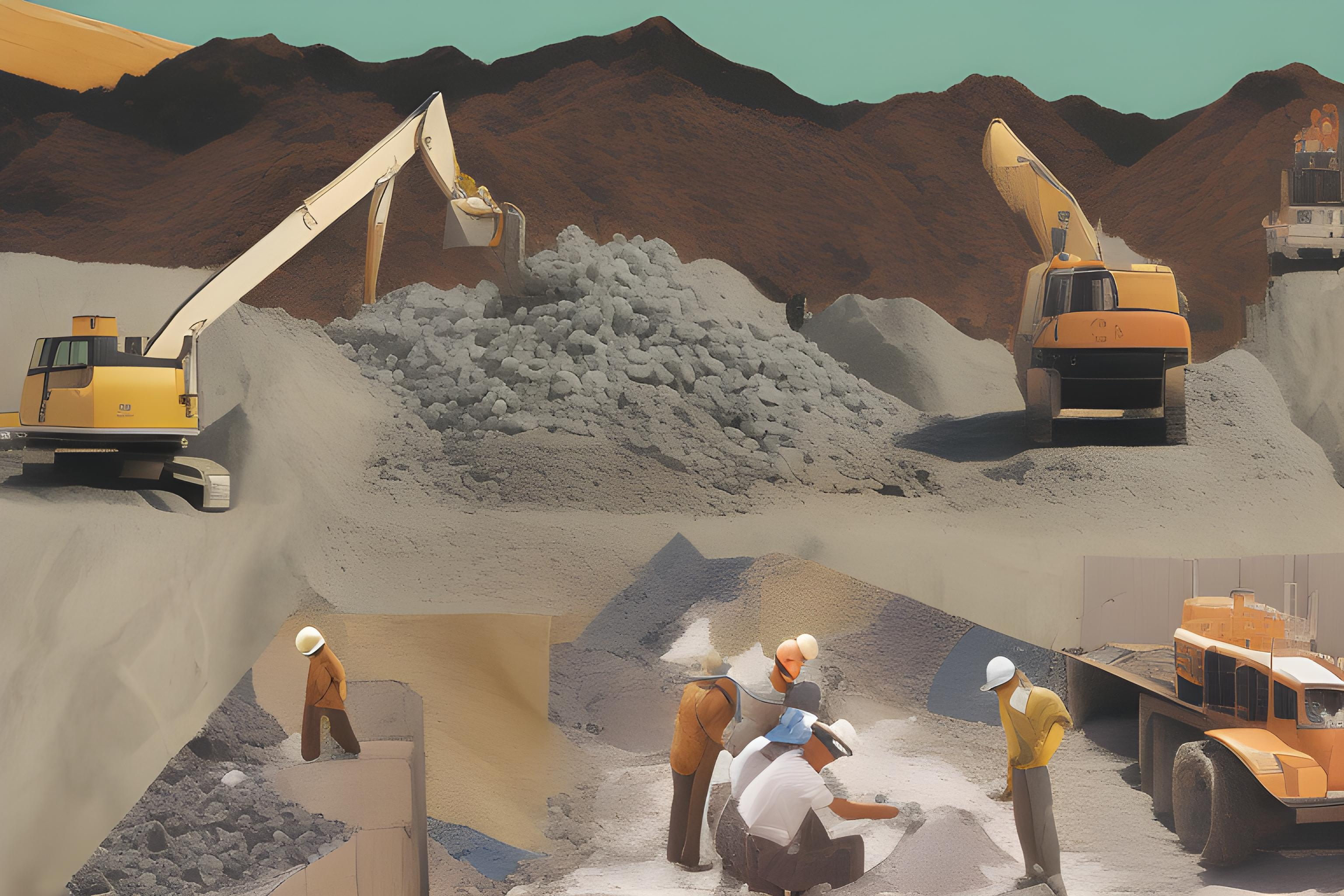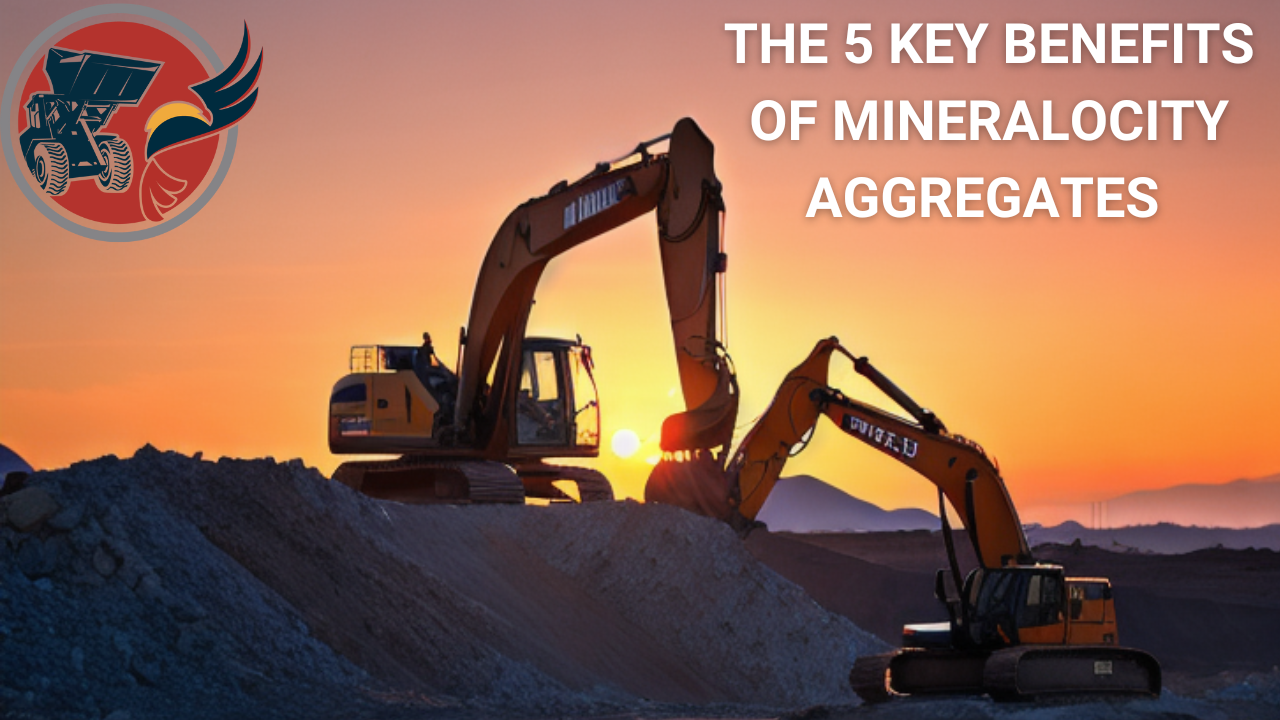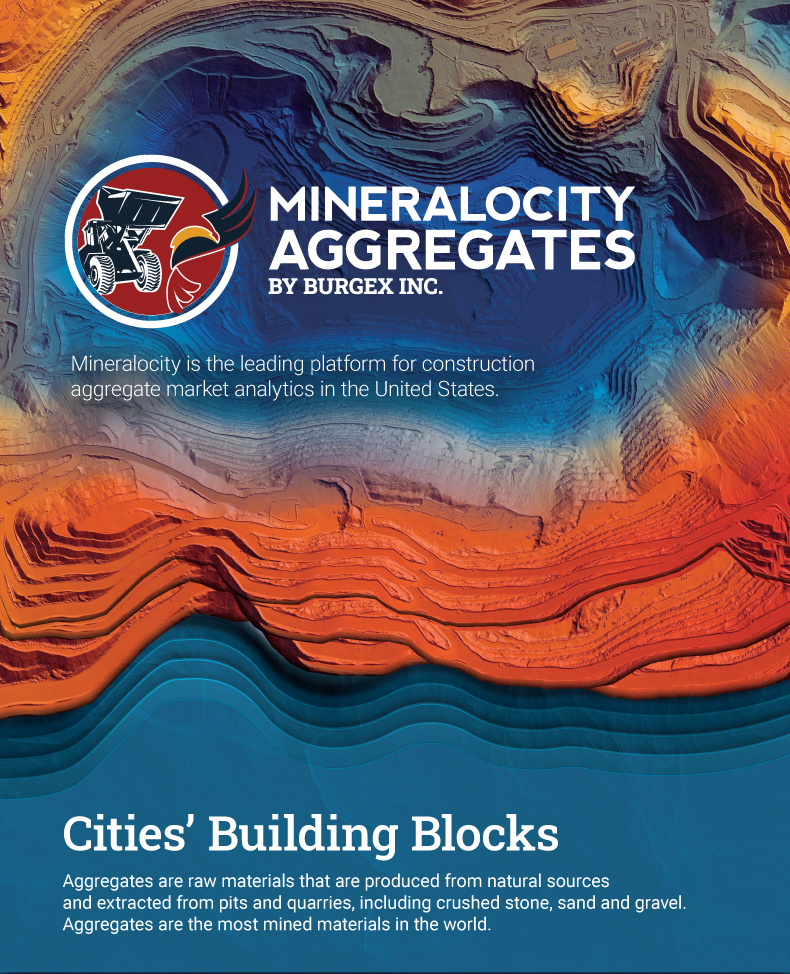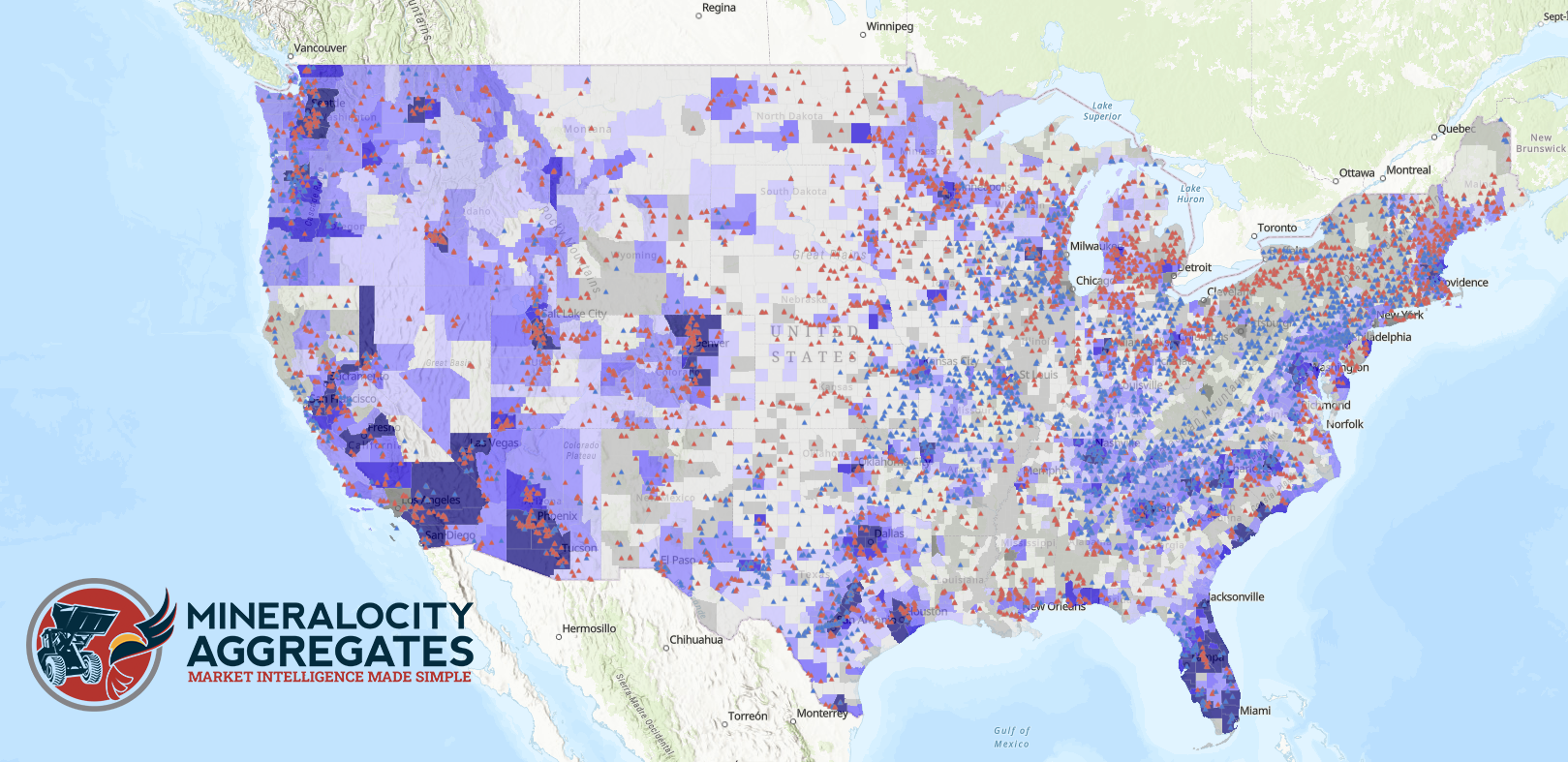The era of AI is upon us, and we’re using it. While we’re seeing incredible value in integrating AI into our everyday work, we also understand the importance of real people and real-life education and experiences.
Contact Us Today
Contact Us Today
The era of AI is upon us, and we’re using it. While we’re seeing incredible value in integrating AI into our everyday work, we also understand the importance of real people and real-life education and experiences.
Explore the top 25 U.S. counties by estimated aggregate demand in 2024. Learn how construction trends, infrastructure investments, and population growth are driving demand for aggregates across key regions.
As we continue to develop and refine the Mineralocity platform, we’re excited to share the powerful capabilities it offers for both greenfield exploration and high-level market research. Whether you’re looking to gain insight into a new area for mineral discovery or analyze broader market trends, Mineralocity is the tool to help you make data-driven decisions with ease.
Explore how data analytics and market analysis enhance decision-making in construction aggregate exploration. Learn how integrating geospatial data, market trends, and production insights can optimize site selection and strategic planning.
When it comes to the construction aggregate industry, the distribution of market share among leading companies can reveal much about the state of competition, barriers to entry, and opportunities for innovation. Using exclusive and proprietary data from Mineralocity Aggregates, this article sheds light on the dynamics of market concentration in the industry across different U.S. states. Specifically, we examine the contrast between states with highly concentrated markets—dominated by a handful of key players—and those with more fragmented landscapes.
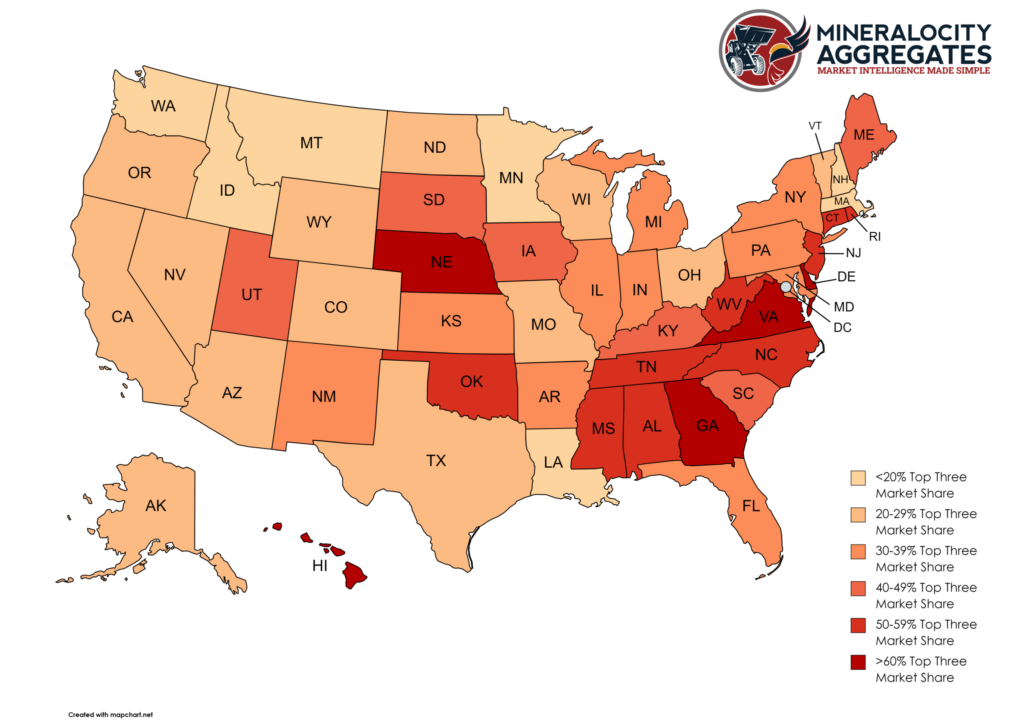
Case Study: Hawaii
In Hawaii, the top three construction aggregate producers—HC&D, LLC, Hawaiian Cement, and West Hawaii Concrete—collectively hold a staggering 90% of the state’s market share. This level of concentration not only demonstrates the grip these companies have on the market but also raises questions about barriers to entry for new players.
Case Study: Nebraska
Similarly, in Nebraska, Martin Marietta Materials, Inc., Kerford Limestone Company, and CRH PLC control 77% of the market. Such a tight grip by a few companies often leads to fewer choices for consumers and could potentially affect pricing strategies.
Case Study: Rhode Island
In Rhode Island, J.R. Vinagro Corporation, Holliston Sand Company Inc, and CRH PLC dominate 58% of the market, again pointing toward high concentration. Here, the influence of these key players is evident not just in their market share but also in their capacity to shape industry trends and practices.
Case Study: Alaska
On the other end of the spectrum, Alaska’s construction aggregate market presents a contrasting picture. Here, the top three producers—Colas S A, Anchorage Sand & Gravel Company Inc, and Brice Incorporated—capture just 24% of the market. This low concentration suggests a more open market landscape, where smaller players can compete more effectively.
Case Study: Minnesota
In Minnesota, the three leading companies—Holcim Group, Martin Marietta Materials, Inc., and MDU Resources Group Inc—account for a mere 12% of the market. Such a fragmented market often encourages innovation and competition, offering more choices to consumers.
Case Study: Montana
Montana mirrors this trend with MDU Resources Group Inc, United Materials of Great Falls, Inc., and Fisher Sand & Gravel Company also holding only 12% of the market share. These statistics indicate that there are likely fewer barriers to entry and possibly more room for disruptive innovation in the state.
Market concentration in the construction aggregate industry across the U.S. is a tapestry of concentrated and fragmented markets, each with its own unique challenges and opportunities. While highly concentrated markets may present fewer opportunities for new entrants, they often indicate a level of stability that could be attractive to investors. On the other hand, fragmented markets could be hotbeds for innovation and diversification.
Whatever the level of market concentration in the construction aggregate industry, understanding these dynamics is crucial for anyone involved in the industry. For those looking for more in-depth analysis, the full report, available for free download, provides comprehensive insights to help you explore growth opportunities, enhance operations, and boost profitability in this demanding market.
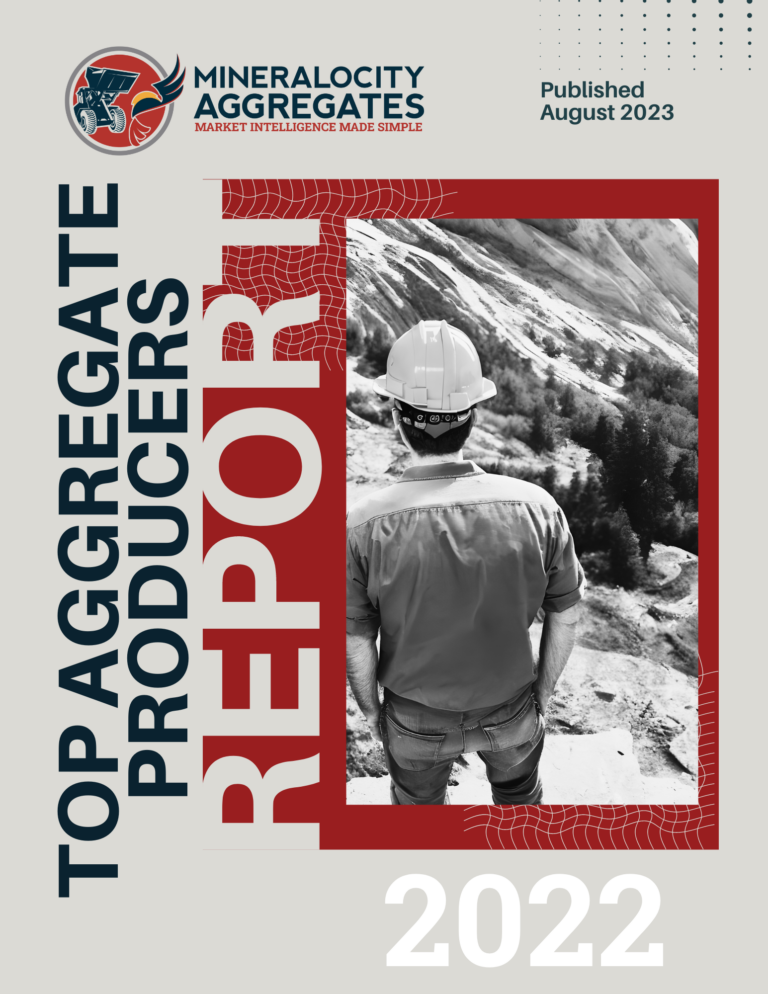
Gain a competitive edge with our 2022 Top Aggregate Producers Report! Get exclusive market share data on top producers in each U.S. state with market trends to strategize effectively. A must-have for every industry player!
In the realm of construction aggregates, producers are constantly on the lookout for strategies to optimize production, reduce costs, and maintain quality. While establishing new sites can bring about fresh opportunities, there’s also great potential lurking beneath existing operations. By “digging deep” into your current site, you can unearth ways to enhance production and ensure the longevity of your operations. Here’s how:
Optimal equipment utilization is about much more than just using machinery. It’s about understanding, adapting, and innovating to ensure that every piece of equipment contributes effectively to the production goals. By focusing on these areas, you can ensure you’re getting the maximum return on equipment investments.
Maintenance and Upkeep: Regularly maintaining your equipment ensures it runs at its optimum capacity. Scheduled checks, preventive maintenance, and timely replacements of worn-out parts can prevent unexpected downtimes, ensuring consistent production rates.
Maximizing Equipment Runtime: By scheduling shifts efficiently and minimizing downtime, you can get the most out of your equipment. This might involve using real-time monitoring systems to identify and rectify issues before they escalate.
Capacity Matching: Ensure that the equipment used is suited for the job’s size and scope. Using equipment that’s too large can lead to unnecessary capital and operational expenses, while equipment that’s too small might not meet production demands.
Training Operators: An equipment piece is only as good as its operator. Training sessions for operators not only ensure safety but also ensure that machinery is used efficiently and optimally. It can significantly reduce operational errors that lead to wear and tear or reduced output.
Evaluate & Upgrade: The aggregate industry, like many others, is continually evolving with the introduction of new technologies. Periodically evaluating and potentially upgrading to more efficient or automated machinery can offer better production rates and reduce costs in the long run.
Custom Solutions: Sometimes, off-the-shelf equipment might not be the best fit for your specific needs. Considering custom solutions or modifications to existing equipment can significantly enhance production capabilities tailored to your site’s unique characteristics.
Training Programs: Equip your team with the skills to operate machinery optimally. Continuous training programs can lead to improved efficiency and reduced waste.
Optimize Workflow: Review your current operational flow. Identify bottlenecks and strategize on how to eliminate them to achieve a more streamlined production process.
Re-evaluate Extraction Methods: Depending on the geological nature of your site, switching up your extraction methods might yield better results. Consider methods that minimize waste and ensure a higher recovery of materials.
Recycling and Reuse: Consider investing in equipment that can recycle used aggregates. This not only reduces waste but can also lead to cost savings in the long run and has proven to be a great business model within metro areas.
Advanced Testing: Embrace advanced testing methods to ensure that your aggregates meet industry standards. This will help maintain client trust and reduce the chances of product returns. You may also find that your resource has the potential to produce additional products and open new potential markets.
Feedback Loops: Create a system where feedback from the end-users of your aggregates is actively collected and acted upon. This can lead to improvements in product quality and better meet market demands.
Site Assessment: Continually assess your site to identify untapped sections that might contain high-quality aggregates. Techniques such as exploratory drilling can offer insights into the depth, extent, and quality of these reserves.
Update or Create Mine Plans: If you’re operating based on older mine plans, it might be time for a revisit. As technology advances and new data becomes available, mine plans can be refined for better optimization. An updated mine plan can help pinpoint exact locations for extraction, ensuring minimal waste and efficient resource utilization.
Lacking a Plan?: If your operation hasn’t had a formal mine plan in place, now is the perfect time to develop one. A well-crafted mine plan guides operations, ensuring that resources are extracted in a logical and sustainable manner. It can also act as a roadmap for future expansions, helping operations forecast potential obstacles and opportunities.
Collaboration with Geologists and Engineers: To create or refine a mine plan, it’s beneficial to collaborate with geologists and mining engineers. Their expertise can help make sense of the data gathered from exploratory drilling and other assessment methods, transforming it into actionable strategies.
Regulatory Compliance: Updated mine plans can also ensure that your operations stay in line with local and federal regulations. This can help avoid potential legal hurdles and ensures the sustainability of your operations in the long run.
Hiring Consultants: Bringing in external expertise, like Burgex Mining Consultants can provide fresh perspectives on your operations. They can identify areas of improvement that might have been previously overlooked and provide strategies to tap into them.
Investing in technology doesn’t mean just buying the latest gadgets. It means integrating modern tools and approaches into the aggregate production process to enhance efficiency, reduce costs, and increase output. In the rapidly evolving technological landscape, staying updated and making informed tech investments can give aggregate producers a competitive edge.
Automation: As the industry progresses, automation solutions have become more accessible and practical. Automated systems in production, loading, and transport can significantly improve efficiency and reduce labor-intensive tasks. Automated crushers, for instance, can optimize rock crushing, and automated conveyor belt systems can increase the transport speed of materials.
Real-time Monitoring: Deploy sensors and equipment fitted with IoT (Internet of Things) capabilities. These can provide real-time data about equipment health, production rates, and operational inefficiencies. By identifying issues as they arise, producers can make instantaneous adjustments, leading to consistent and optimized production.
Data Analytics: With the large volumes of data generated from real-time monitoring, utilizing data analytics can offer actionable insights. By analyzing patterns, you can anticipate maintenance needs, adjust for efficiency, and forecast production capabilities.
Drones: Utilize drones for site mapping, stockpile measurements, and monitoring. Drones can provide accurate data faster and more safely compared to manual inspections, enabling better decision-making.
Software Solutions: Invest in software tailored for the aggregate industry. Software solutions can aid in tasks ranging from inventory management and production tracking to predictive maintenance and financial forecasting.
Sustainable Technologies: With increasing emphasis on sustainability, look into technologies that reduce emissions, recycle water, and minimize waste. For instance, electric-powered equipment might offer a sustainable alternative to diesel-powered machinery in certain applications.
Mobile Applications: Equip your on-ground teams with mobile applications that allow them to report, monitor, and communicate more effectively. This can significantly streamline operations and improve response times to any challenges that arise.
Enhancing production in existing aggregate sites is all about understanding your current resources and optimizing them. With a keen focus on continuous improvement and a willingness to adapt to modern methods and technologies, producers can ensure that their sites continue to yield high-quality aggregates for years to come. For those looking to dive even deeper into the nuances of the aggregate market, tools like Mineralocity Aggregates offer invaluable insights to stay ahead in this dynamic industry.
Mineralocity Aggregates, our dynamic and versatile platform, is equipped with a plethora of features designed to elevate your operations. To get you started, here’s a curated list of the most beneficial functionalities that truly set it apart.
1) Wealth of Market Knowledge: The robust Mineralocity Aggregates platform provides clients with a vast range of market intelligence and knowledge, granting them access to insights that may not otherwise be available within their organization.
2) Greenfield Opportunities: Our tool streamlines the often-complex process of site selection for new quarry development. While it doesn’t provide all the answers, it excels at identifying specific areas and regions suitable for new pit/quarry development, proving invaluable to any producers looking to expand.
3) Strategic Planning: With features such as drivetime analysis and the ability to visualize competitors, markets, and transportation, Mineralocity Aggregates empowers producers to enhance strategic planning for existing operations. The platform enables producers to better utilize their operations and position themselves more competitively.
4) Risk Mitigation: Mining comes with inherent risks. Mineralocity Aggregates helps alleviate some of these by providing the ability to assess both current and future markets. This enables producers to prepare for future demand changes and adjust production strategies accordingly.
5) Identifying Trends and Market Opportunities: Many producers lack comprehensive market data outside of their local area, obscuring potential regional opportunities. Even a single quarry operation can use Mineralocity Aggregates to uncover opportunities for their products that might otherwise remain hidden. Most operators still rely on spreadsheets or even paper notebooks to track local markets. Our tool significantly enhances their capabilities with full visualization and the ability to identify trends and opportunities at a glance. Regularly updated data adds further peace of mind, making our platform an advantageous investment even for smaller producers.
In summary, Mineralocity Aggregates empowers producers to make better decisions, maintain or gain a competitive edge, and reduce risks within their business.
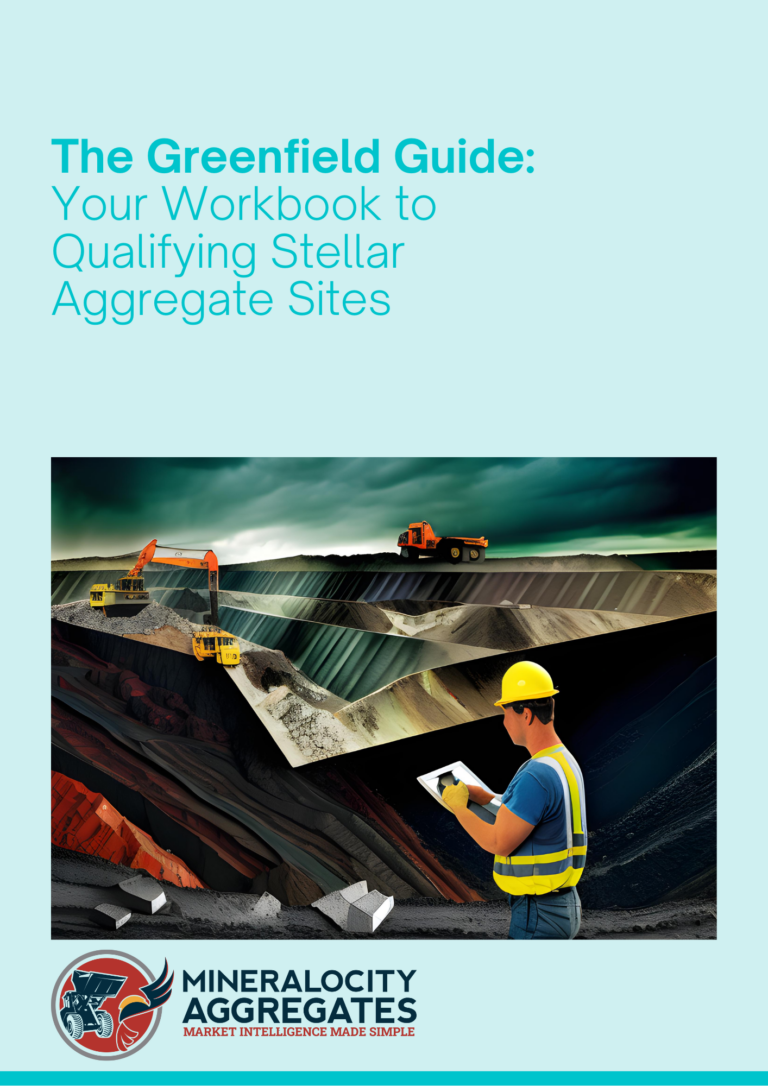
Dive deeper into the world of construction aggregate production with our exclusive Greenfield Guide. Whether you’re a seasoned expert or just embarking on your aggregate adventure, this guide is your roadmap to identifying prime locations, assessing supply potential, and capturing significant market shares. Arm yourself with proven strategies, actionable insights, and essential formulas designed to propel your projects to unparalleled success. Don’t miss this chance to elevate your greenfield endeavors – grab your free copy of the Greenfield Guide now!
As the CEO of Burgex Mining Consultants, I’ve always been driven by a powerful and inspiring purpose – to create a better, more sustainable future by advancing the synergies between humanity and nature. This conviction is at the very core of our company, guiding every decision we make and shaping the way we approach our work in the mineral resource and aggregate industries.
Our “why” statement, influenced by Simon Sinek’s Golden Circle concept, encapsulates this vision:
In line with this mission, we’ve also developed a ‘Why’ for our Mineralocity initiative, which focuses on the importance of aggregate projects in maintaining robust and healthy infrastructure:
“We aim to educate, advocate, and promote aggregate projects that help keep our infrastructure robust and healthy.”

To realize this goal, I have established a clear strategy for Burgex that revolves around three key pillars: education, advocacy, and the promotion of responsible exploration projects. As a U.S. company, we are dedicated to empowering our nation by reducing its reliance on foreign supplies and championing sustainable domestic resource development.
What truly sets Burgex apart, however, is our unwavering commitment to providing our clients with exceptional expertise and clarity. We take pride in guiding our clients through the complexities of the mining industry and helping them unlock the full potential of their mineral resource projects in a responsible and environmentally conscious manner.
This steadfast dedication to our “why” is what elevates Burgex beyond a mere mining consultancy. We are a catalyst for change, a beacon of hope, and a living example of how purpose-driven organizations can make a tangible difference in the world. By centering our belief in a sustainable future at the heart of our operations, we embody the ideals of responsible business practices and environmental stewardship.
As we face an ever-changing global landscape, the need for responsible resource development becomes increasingly paramount. I am proud to lead Burgex Mining Consultants on this vital mission and am deeply committed to fostering a brighter, more sustainable future that embraces the harmony between humanity and the natural world.
Chris Summers, CEO of Burgex Mining Consultants
Q: What is your role at Burgex?
I am a mining engineer, specifically within the consulting group. I started my career seven years ago doing mining engineering work in the construction aggregate space and have been at Burgex for more than three years.
Q: What types of projects do you typically work on?
Mine design, and mine planning such as mine/site layouts, pit shells, volume calculations, production schedules, cycle times, equipment matching and selection.
Valuation work that focuses on implementing a mine plan and calculating operating costs into the life-of-mine plan, all of which feed into the valuation.
I also run models and analyses on currently operating quarries to estimate annual production to evaluate supply that is entering a particular market.
Q: When a client comes to Burgex with a general area of interest, how do you help them determine if a site is worth pursuing?
Before Mineralocity, we did a lot of Preliminary Assessment for Site Suitability (PASS) reports. They are very high-level reviews that report on the local market of a site, and the technical feasibility of that site. An analysis is done on a site-by-site basis, as the models require input of the tract boundary to run properly. We give the site a letter grade from A+ to F, in two categories: market, and technical feasibility. This allows our clients to quickly compare multiple sites and helps them decide where to allocate resources to progress further.
Q: What if a client only has a vague idea of where they want to look to expand or start a new greenfield location?
This is where Mineralocity comes in. It’s hard to choose an area, but we have an idea of where there is a lot of demand for aggregate. It’s really difficult to say whether one area is better than another. It depends on all the other suppliers in the area and distance from metro or population centers, so it can be very difficult to look generally, like a full state or region, unless you have a tool like Mineralocity. With Mineralocity the entire United States can be visualized, and every active producer for construction aggregate can be seen with our GIS-based platform. The map has colorized symbology based on PASS report scoring for easy understanding of where to start looking. With a map like that, it is easy to see how one area compares with another. We also use Mineralocity to perform market share analysis and help our clients identify possible growth opportunities via mergers and acquisitions (M&A).
Q: If a client did the initial market study themselves using Mineralocity, how much time could they potentially save?
Well, it’s not terribly complicated to analyze a potential site if you have the data, and for the most part clients usually have a good idea as to whether it is a “good site“ or not. What would really save a client time is to run this analysis repeatedly on multiple potential site locations. The amount of data you can get from Mineralocity is the same as one of our professional analysis PASS reports, which can take a few hours just to find out that it is not a good site, or whether they should look somewhere else. In Mineralocity, with a simple click of the mouse they will instantly know if they should pursue a location or not. That is a real time-saver.
It is amazing how much data we have incorporated into the platform, but there is so much more on the back end that feeds into it. When a client does this on their own they must comb through so much data, which is incredibly time-consuming. Mineralocity can show a summary of all the data very concisely. If more depth or explanation is needed for all the datasets incorporated, our consulting team can provide that additional expertise.
Q: Ideally clients will use the Mineralocity platform to refine their area of interest to a couple of sites. How does Burgex further help them advance that area?
Mineralocity can really help clients discover a more refined area, but it’s hard to put all the back end data into the platform in a way that it can be seen.
The ideal workflow would be:
Client picks a site and evaluates it using Mineralocity to determine where there is good demand, population, supply in the area, favorable geology, and where the population is growing or declining. We are currently working on adding parcel data to determine if the land is available or not.
Burgex assesses that specific site and investigates it more deeply, starting with its geology to make sure the material on site passes Department of Transportation specifications. Burgex then investigates the specific market, pricing, production costs, and conducts a study of where in the market that material will go.
By doing this further analysis, we can give the client a fully detailed market report on their potential site and they can make an educated decision on whether to pursue the site or not.

When I started at Burgex Mining Consultants more than two-and-a-half years ago, Mineralocity Aggregates was an idea, a thought, a “what if” dreamed up by Stuart Burgess and Chris Summers. Today, as Mineralocity Aggregates team lead, I have the privilege of introducing Mineralocity Aggregates to government agencies, consulting firms, investment companies, aggregate producers, and suppliers to the aggregate industry. I assist subscribers and potential subscribers with access to the platform, billing questions, functionality, data interpretation, and more.
It has been my pleasure to watch this great idea become an even greater reality. I have watched the idea turn into a concept, then a plan, then go through development and production, and finally to be introduced into the market. Mineralocity Aggregates really is Market Intelligence Made Simple.
Now suppliers to the aggregate industry use this powerful tool to better understand their customers and products, and to focus on and create sales strategy plans. Producers gain a better understanding of their competition to develop plans for M&A as well as greenfield expansion.
Mineralocity Aggregates was officially introduced to the public on June 15, 2022. With input from beta testers, subscribers, and free trial users, we have determined which functionalities users desire. By incorporating Dodge Construction Data into the platform we will now enable users to see where funds will be spent so those areas of growth can be targeted. We will also launch a new version of Mineralocity Aggregates that will be more interactive and will allow users to import and export data.
I enjoy the opportunity to watch Mineralocity Aggregates grow from an idea into a valuable tool for our subscribers.
If you’re attending CONEXPO CON/AGG, stop by our booth for a demonstration and see for yourself how Mineralocity can benefit you and get your black truck! March 13th– 18th, booth N10321
If you have any questions, please feel free to reach out to me personally at
801-648-6463 or jdeems@burgex.com.
Unlock the untapped potential of over 10,000 U.S. commercial mining operations mapped on our platform, Mineralocity! Dive into our supply and demand grids, explore detailed geology with production analysis, evaluate surplus and distribution, take advantage of our extensive rail/transport data, and stay ahead with population trends and more! From aggregates to precious metals, Mineralocity brings a wealth of mining data and insights right to your fingertips!

